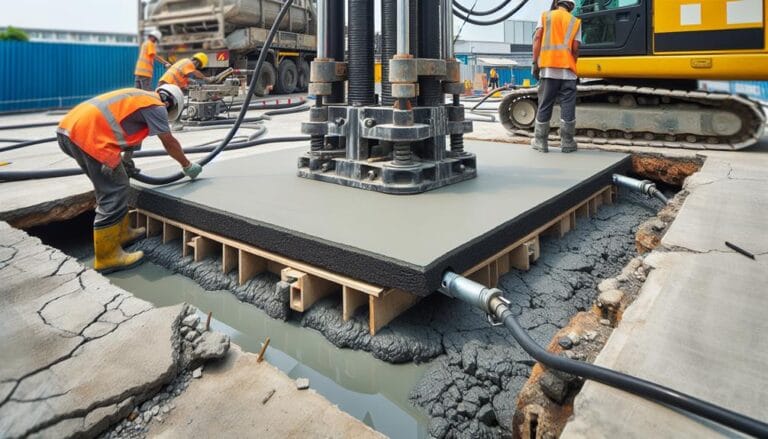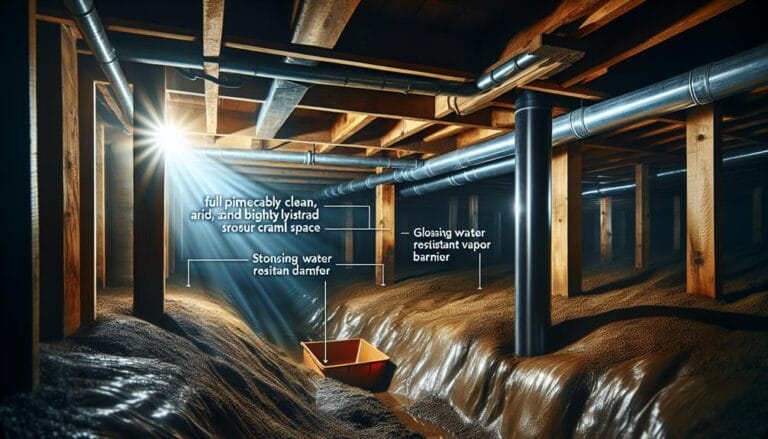Why Home Foundations Crack in Washtenaw County
We've noticed that home foundations in Washtenaw County often crack due to changes in soil moisture, improper drainage leading to water accumulation around the foundation, and poor engineering or construction methods. These issues can cause uneven floor levels, leaning walls, and gaps in woodwork. To identify the source of cracks, we conduct thorough foundation inspections and analyze soil conditions. If we see visible signs of water damage, shifting foundations, or malfunctioning windows and doors, it is clear immediate repairs are necessary. We must stay vigilant and take steps to prevent future cracking by ensuring proper water drainage, maintaining soil conditions, and keeping trees and plants at a safe distance.
Key Takeaways
- Soil movement due to moisture changes, poor drainage, and tree roots can cause foundation cracks in Washtenaw County.
- Improper construction methods and natural disasters like floods and earthquakes also contribute to foundation cracks.
- Vertical cracks are common due to the area's expansive clay soils and the resulting settlement.
- Clogged gutters, poor yard grading, and leaky plumbing are other causes of foundation cracks.
Causes of Home Foundation Cracks
While discussing the issues that can lead to foundation cracks, it is important to highlight the main reasons behind this problem.
Let's examine the reasons why cracks appear in home foundations. Soil movement is a significant cause of foundation cracks. It can occur when there are changes in soil moisture levels, leading to expansion and contraction. This constant shifting creates pressure on the foundation, which eventually leads to cracks. Moisture issues are also a common cause, often due to improper drainage. If water accumulates around the foundation, it can weaken the structure and cause cracks to appear.
Furthermore, other factors contribute to foundation cracks. For instance, tree roots can push into the foundation as they search for water, and the roots can even cause uneven settlement, creating cracks. Poor engineering or foundation construction also plays a significant role in the formation of cracks. Finally, natural disasters like flooding and earthquakes can also contribute to foundation damage.
Understanding these causes is vital to identify the appropriate solutions and to prevent extensive damage to our homes.
Symptoms of Structural Damage
In Washtenaw County, foundation cracks are a common occurrence. Sometimes, these cracks are minor and cause little concern. However, when we notice signs of structural damage, such as uneven floor levels, leaning walls, or gaps in woodwork, we cannot afford to ignore them. These issues can compromise the overall foundation stability and potentially lead to significant defects in the structural integrity of our homes.
As the environmental conditions around our homes change, so does the soil composition beneath the foundation. This can lead to cracks and shifts over time. For instance, expansive clay soils commonly found in Washtenaw County can cause vertical cracks due to their tendency to absorb and release moisture. Additionally, any considerable changes in the soil composition can cause the foundation to shift.
Watching out for these signs of structural damage is essential to quickly assess and address potential problems. Prompt action can save us from further degradation and help maintain a safe and stable living environment. By understanding these symptoms and their causes, we can take the necessary steps to prevent more significant issues from developing.
Common Signs of Leaks
Now that we recognize the symptoms of structural damage, we need to monitor our foundations for leaks, as water penetration can further exacerbate any existing issues and lead to more significant problems down the line. If we identify signs of water intrusion early on, we can take steps to address the issue before it becomes catastrophic. One of the primary indicators of water leaks includes musty smells or mold growth in our basement or crawl space. These unpleasant odors often arise from moisture buildup, which can seep into our home through cracks in the foundation or poor drainage.
If we suspect a leak, it's essential to inspect our home's foundation and surrounding areas closely. Look for signs such as uneven or sagging floors, bowed or cracked walls, and sticky doors or windows. Additionally, pay attention to the performance of our gutter system, ensuring it is functioning correctly to channel water away from the house. By staying vigilant and taking prompt action when we detect leaks, we can mitigate additional structural damage and protect our home from further deterioration.
Determining the Source of Cracks
When evaluating cracks in our home's foundation, it is essential to identify the cause promptly to develop an effective repair strategy, as even seemingly minor cracks can hide serious structural threats.
A thorough foundation inspection is vital in determining the source of these cracks. During an inspection, we should be keenly observant of signs like musty odors, water stains, and mold clusters. It is equally important to perform a soil analysis to explore the possibility of soil movement or settlement.
Inadequate soil compaction, poor drainage, and tree roots can be significant contributors to cracks. Soil erosion, too, should not be overlooked. Weather extremes, such as floods and droughts, can also lead to cracks in the foundation.
Necessity of Immediate Repairs
We must address foundation cracks promptly to prevent them from escalating into more severe and costly structural issues. Ignoring these cracks can lead to catastrophic consequences, jeopardizing the safety and stability of our homes. Logical reasoning and a commitment to regular inspections are key to ensuring the continued integrity of our foundations.
Several red flags signal the necessity for immediate repairs:
- Visible Signs of Water Damage: Musty smells, mold growth, and moisture seepage indicate water penetration, which weakens the structural support and necessitates swift intervention.
- Shifting or Cracking Foundation: Hairline cracks or more significant damage points to settlement issues that demand prompt professional evaluation and correction.
- Window or Door Malfunctions: Stuck windows or doors can hint at underlying foundation problems, demanding immediate assessment and repair.
- Changes in Soil Composition: Alterations in soil moisture, especially in areas prone to earthquakes or extreme weather patterns, require vigilant monitoring and response.
Swift action and monitoring allow us to safeguard our homes from the far-reaching effects of neglected foundation cracks. We must prioritize the integrity of our homes and our well-being by actively addressing these issues forthright.
Preventing Future Cracking Issues
Our homes are constantly at risk of developing new foundation cracks, so it's important to understand the preventative measures we can take beyond just addressing current issues. To guarantee our foundations remain strong and secure, we must incorporate regular maintenance into our routine. One key step is to verify proper water draining around our homes. This includes maintaining clean gutters and making sure the ground slopes away from the foundation. By doing so, we can prevent water from collecting near the foundation and reducing hydrostatic pressure, a major cause of cracks.
Another essential aspect of preventive maintenance is monitoring soil conditions. For regions with sandy soil, like Michigan, it's crucial to address moisture issues promptly, as shifting soil can cause foundation stress leading to cracks. Additionally, making sure that trees and other plants are at a safe distance from our homes and foundations can help prevent root growth intrusion, which can exert pressure on the foundation and cause cracks. By staying vigilant and proactive, we can greatly lower the likelihood of future cracking issues and safeguard our homes from these problems.
Frequently Asked Questions
What Inspection Codes Does the Washtenaw County Building Department Enforce?
'We guarantee homeowner safety by enforcing the State Construction Code, which covers building, mechanical, plumbing, and electrical systems. Our inspectors follow strict guidelines for thorough reviews of property compliance.'
How Does Washtenaw County Handle Permits for Construction Projects?
"We manage permits for construction projects through regulated permit applications, ensuring compliance with Washtenaw County's construction regulations."
Are Trade Inspections Charged per Trip or per Inspection in Washtenaw County?
"As we navigate Washtenaw County's permit procedures, we find that trade inspections are charged per trip, not per inspection. This means that multiple inspections can be performed without extra fees, keeping the inspection fees economically efficient."
What Are the Plan Requirements for Inspections in Washtenaw County?
We schedule inspections through the Energov portal or IVR system, guaranteeing timely completion. Washtenaw County enforces state codes with strict foundation regulations; we follow the required inspection timelines to guarantee compliance.
Can Washtenaw County Building Department Handle Inspections for Electrical Issues?
'We guarantee electrical safety in Washtenaw County by overseeing the inspection process, where our diligent teams scrutinize electrical systems to prevent potential hazards, guaranteeing that all standards are meticulously upheld.'







